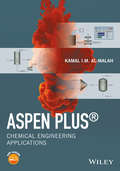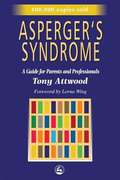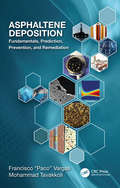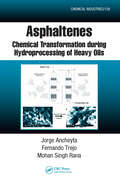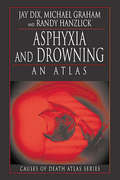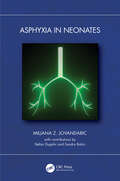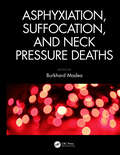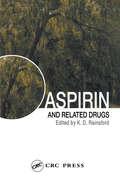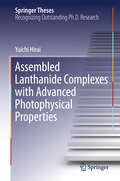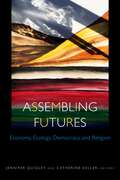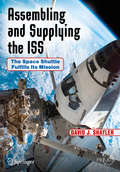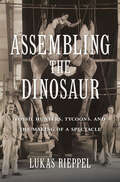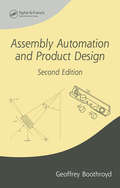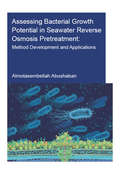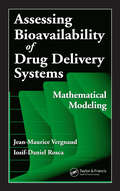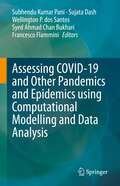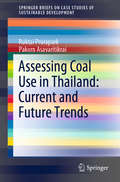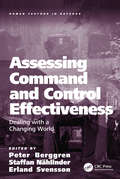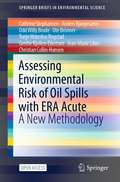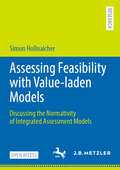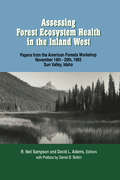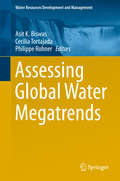- Table View
- List View
Aspen Plus: Chemical Engineering Applications
by Kamal I.M. Al-MalahFacilitates the process of learning and later mastering Aspen Plus® with step by step examples and succinct explanations Step-by-step textbook for identifying solutions to various process engineering problems via screenshots of the Aspen Plus® platforms in parallel with the related text Includes end-of-chapter problems and term project problems Includes online exam and quiz problems for instructors that are parametrized (i.e., adjustable) so that each student will have a standalone version Includes extra online material for students such as Aspen Plus®-related files that are used in the working tutorials throughout the entire textbook
Asperger's Syndrome: A Guide for Parents and Professionals
by Tony AttwoodA book designed for parents and teachers alike on Asperger's Syndrome. The information in this book is also applicable to individuals who are labeled as high functioning Autism. An excelent resource for anyone who works with an individual with a disorder on the autism spectrum.
Asphaltene Deposition: Fundamentals, Prediction, Prevention, and Remediation
by Francisco M. Vargas and Mohammad TavakkoliAs global consumption of fossil fuels such as oil increases, previously abundant sources have become depleted or plagued with obstructions. Asphaltene deposition is one of such obstructions which can significantly decrease the rate of oil production. This book offers concise yet thorough coverage of the complex problem of asphaltene precipitation and deposition in oil production. It covers fundamentals of chemistry, stabilization theories and mechanistic approaches of asphaltene behavior at high temperature and pressure. Asphaltene Deposition: Fundamentals, Prediction, Prevention, and Remediation explains techniques for experimental determination of asphaltene precipitation and deposition and different modeling tools available to forecast the occurrence and magnitude of asphaltene deposition in a given oil field. It discusses strategies for mitigation of asphaltene deposition using chemical inhibition and corresponding challenges, best practices for asphaltene remediation, current research, and case studies.
Asphaltenes: Chemical Transformation during Hydroprocessing of Heavy Oils (Chemical Industries)
by Jorge Ancheyta Fernando Trejo Mohan Singh RanaDuring the upgrading of heavy petroleum, asphaltene is the most problematic impurity since it is the main cause of catalyst deactivation and sediments formation. Exploring many aspects related to asphaltenes composition and conversion, Asphaltenes: Chemical Transformation during Hydroprocessing of Heavy Oils highlights the various changes that thes
Asphyxia and Drowning: An Atlas (Cause of Death Atlas Series)
by Jay Dix Michael Graham Randy HanzlickThis third volume in the Forensic Pathology Atlases: Causes of Death Series provides an overview of the types, mechanisms, and physical findings associated with deaths involving asphyxia. Asphyxia and Drowning serves as a basic framework for an extensive pictorial representation of findings associated with these types of deaths. It helps the reader
Asphyxia in Neonates
by Miljana Z. JovandaricIn severe asphyxia, lipid peroxidation occurs. Neonatal lipid concentration may indicate the severity of asphyxia and be a reason for needing cooling therapy. Asphyxia in Neonates describes the results of research into the impact oxygen deficits in neonates. The physiological consequences of asphyxiated newborn infants include changes in the pH of plasma and changes in lipid concentrations. These changes can result in apoptosis, loss of cell membrane integrity, and damage to the brain.Features Reviews pathophysiology of asphyxia Describes the influence of asphyxia on lipids concentrations Summarizes the weight distribution of neonates with asphyxia based on lipid concentration Illustrates the use of lipids as an indicator of prognosis following asphyxia Provides guidance for lipids parameters in cooling therapy
Asphyxiation, Suffocation, and Neck Pressure Deaths
by Burkhard MadeaCombining theory and practice, this is a comprehensive analysis of suffocation, asphyxiation, and neck pressure deaths. It includes important developments in the field such as lung histomorphology in fatal strangulation, systematic dissection of the larynx, biochemical findings, and post-mortem imaging. Given the significant challenges in accuratel
Aspirin and Related Drugs
by K. D. RainsfordReviewing over a century of aspirin research and use, Aspirin and Related Drugs provides a comprehensive source of information on the history, chemistry, absorption in the body, therapeutic effects, toxicology, elimination, and future uses of aspirin.Highlighting the historical evolution of the salicylates and the commercial development of
Assembled Lanthanide Complexes with Advanced Photophysical Properties (Springer Theses)
by Yuichi HiraiNominated as an outstanding PhD thesis by Hokkaido University.<P><P> Expands readers’ understanding by explaining the details of how to synthesize and measure assembled lanthanide complexes.<P> Provides detailed, unprecedented information on microscopy and computation aspects.<P> This thesis provides essential information on the systematic design of assembled lanthanide complexes for functional luminescent materials. It discusses the relationships between assembled structures and photo, thermal, and mechanical properties on the basis of crystallography, spectroscopy, and thermodynamics. The described guidelines for assembled structures will be extremely valuable, both for industrial applications and for readers’ fundamental understanding of solid-state photophysics and materials chemistry.<P> Luminescent lanthanide complexes are promising candidates for lighting devices, lasers, and bio-probes owing to their line-like and long-lived emission arising from characteristic 4f–4f transitions. Low-vibrational and asymmetrical coordination structures around lanthanide ions have been introduced to achieve strong luminescence, using specific organic ligands. Recently, assembled lanthanide complexes including coordination polymers and metal organic frameworks have increasingly attracted attention as a new class of luminescent materials offering thermal stability and color tunability. However, improving the luminescence efficiencies of these compounds remains a challenge, and specific molecular designs to control assembled structures and yield additional physical properties have not been established. The author provides a group of bent-angled bridging ligands to boost photoluminescence efficiency, and successfully introduces for the first time glass formability and strong triboluminescence properties.
Assembling Futures: Economy, Ecology, Democracy, and Religion (Transdisciplinary Theological Colloquia)
by Jennifer Quigley and Catherine KellerTransdisciplinary insights at the intersection of religion, democracy, ecology, and economyWhat is the relationship of religion to economy, ecology, and democracy? In our fraught moment, what critical questions of religion may help to assembly democratic processes, ecosystems, and economic structures differently? What possible futures might emerge from transdisciplinary work across these traditionally siloed scholarly areas of interest?The essays in Assembling Futures reflect scholarly conversations among historians, political scientists, theologians, biblical studies scholars, and scholars of religion that transgress disciplinary boundaries to consider urgent matters expressive of the values, practices, and questions that shape human existence. Each essay recognizes urgent imbrications of the global economy, multinational politics, and the materiality of ecological entanglements in assembling still possible futures for the earth. Precisely in their diversity of disciplinary starting points and ethical styles, the essays that follow enact their intersectional forcefield even more vibrantly.
Assembling Nusantara: Mimicry, Friction, and Resonance in the New Capital Development (Advances in 21st Century Human Settlements)
by Lilis Mulyani Henny Warsilah Ivan Kurniawan NasutionToday, the new Indonesian capital city, Nusantara, planning is being anticipated as “representing national identity,” “a model city,” or “a gift to the world,” and many other extraordinary labels. This book examines the reality of an ongoing developmental transformation of the Nusantara beyond those labels. It approaches its assemblage of humans, their works (plans, documents, policies, and others), non-human objects (biodiversity, landscape, geography, physical infrastructure, buildings, and public spaces), processes, social relationships, social infrastructures, and others. It is organized into three themes—mimicry, friction, and resonance. The mimicry illustrates the similarities (and differences) between Nusantara and other capital cities in urban narratives, imageries, and forms. The friction studies how Nusantara moves actors who do not always agree, processes that do not always align or collaboration between diverse contradicting groups that intersect. The resonance observes how Nusantara resonates with, yet communicates its voice toward, the world. The three concepts (originated from geography, anthropology, and sociology) frame the analytics of the various contributions of local and foreign scientists from multiple disciplines. Overall, the book recommends “Otorita Ibu Kota Nusantara” (Nusantara capital city authority) on the current experimentation and implementation of the urban vision and provides a reference for social scientists to study Nusantara. And more broadly, the book offers the current socio-spatial practices of capital city-making in Asia that are valuable for the region.
Assembling and Supplying the ISS: The Space Shuttle Fulfills Its Mission (Springer Praxis Books)
by David J. ShaylerThis book tells the story of the International Space Station from the perspective of the space shuttle's involvement in how the assembly and re-supply of the station evolved. It captures how the intricate and wide-reaching infrastructure required by each mission was managed and provides a comprehensive view of the relationship between the shuttle and ISS. The success in assembling the ISS over a period of 13 years came after gaining experience by sending the space shuttle to the Russian Mir space station in a three-year period during the second half of the 1990s, and after years of detailed study and evaluation. This book reviews those developments and how years of planning, hopes and dreams were turned into reality between 1995 and 2011. It provides detailed reviews of the space shuttle missions at space stations, including how the skills were developed to achieve these missions, what happened on those flights, and how lessons learned from one mission were applied to subsequent operations. Note that no mission failed in its main objective across nine Mir dockings and one rendezvous mission and 37 shuttle flights to the ISS. The smoothness and reliability of actual station operations masks the years of hard work that went into each mission both in space and on the ground. Using first-hand research, personal interviews and contemporary sources, an alternative story of the space shuttle is portrayed.
Assembling the Dinosaur: Fossil Hunters, Tycoons, and the Making of a Spectacle
by Lukas RieppelLukas Rieppel shows how dinosaurs gripped the popular imagination and became emblems of America’s industrial power and economic prosperity during the Gilded Age. Spectacular fossils were displayed in museums financed by North America’s wealthiest tycoons, to cement their reputation as both benefactors of science and fierce capitalists.
Assembling the Dinosaur: Fossil Hunters, Tycoons, and the Making of a Spectacle
by Lukas RieppelA lively account of the dinosaur’s role in Gilded Age America, examining the connection between business, paleontology, and museums.Although dinosaur fossils were first found in England, a series of dramatic discoveries during the late 1800s turned North America into a world center for vertebrate paleontology. At the same time, the United States emerged as the world’s largest industrial economy, and creatures like Tyrannosaurus, Brontosaurus, and Triceratops became emblems of American capitalism. Large, fierce, and spectacular, American dinosaurs dominated the popular imagination, making front-page headlines and appearing in feature films.Assembling the Dinosaur follows dinosaur fossils from the field to the museum and into the commercial culture of North America’s Gilded Age. Business tycoons like Andrew Carnegie and J. P. Morgan made common cause with vertebrate paleontologists to capitalize on the widespread appeal of dinosaurs, using them to project American exceptionalism back into prehistory. Learning from the show-stopping techniques of P. T. Barnum, museums exhibited dinosaurs to attract, entertain, and educate the public. By assembling the skeletons of dinosaurs into eye-catching displays, wealthy industrialists sought to cement their own reputations as generous benefactors of science, showing that modern capitalism could produce public goods in addition to profits. Behind the scenes, museums adopted corporate management practices to control the movement of dinosaur bones, restricting their circulation to influence their meaning and value in popular culture.Tracing the entwined relationship of dinosaurs, capitalism, and culture during the Gilded Age, Lukas Rieppel reveals the outsized role these giant reptiles played during one of the most consequential periods in American history.Praise for Assembling the Dinosaur“A penetrating study of legitimacy and capitalism in the realm of fossils.” —Verlyn Klinkenborg, The New York Review of Books“A solid entry into the growing body of literature on Gilded Age American paleontology, but it is particularly valuable for its contribution to enhancing our understanding of how science and its representation during that period were influenced by, and in turn affected, society as a whole. By incorporating cultural, economic, and scientific developments, Rieppel shines new light on the history of both American paleontology and museum exhibition practice.” —Ilja Nieuwland, Science
Assembly Automation and Product Design (ISSN)
by Geoffrey BoothroydThe design for assembly (DFA) method has become a widely used way for companies to introduce competitive designs at reduced costs. This text places the consideration and application of automatic assembly in the context of DFA, addressing product design for both automated and manual assembly processes. The author enumerates the components, processes, performance, and comparative economics of several types of automatic assembly systems. To this end, the book includes specific information on equipment such as transfer devices, parts feeders, feed tracks, placing mechanisms, and robots. This is an ideal reference and guide for manufacturing, product design, mechanical, and industrial engineers.
Assessing Accomplished Teaching: Advanced-Level Certification Programs
by National Research Council of the National AcademiesThe mission of the National Board for Professional Teaching Standards (NBPTS) is to establish “high and rigorous standards for what teachers should know and be able to do, to certify teachers who meet those standards, and to advance other education reforms for the purpose of improving student learning in American schools.” In response to a request from the U.S. Congress, the National Research Council developed a framework for evaluating programs that award advanced-level teacher certification and applied that framework in an evaluation of the impacts of the NBPTS. Specifically, this book addresses the impacts on students, teachers, and the educational system in this country. Assessing Accomplished Teaching finds that teachers who earn board certification are more effective at improving their students’ achievement than other teachers, but school systems vary greatly in the extent to which they recognize and make use of board-certified teachers. Many of the questions on the evaluation framework could not be answered because the data have not been collected, and the report makes recommendations for the kinds of research that are needed to fully evaluate the impacts of board certification by the NBPTS.
Assessing Bacterial Growth Potential in Seawater Reverse Osmosis Pretreatment: Method Development and Applications (IHE Delft PhD Thesis Series)
by Almotasembellah AbushabanSeawater desalination is increasingly being used as a means to augment freshwater supplies in regions with high water stress, and reverse osmosis is increasingly the technology of choice because of the low energy consumption. However, seawater reverse osmosis (SWRO) systems suffer from various types of fouling, which can increase energy consumption and the use of chemicals during SWRO operation. In practice, pre-treatment systems are put in place to reduce the particulate and biological fouling potential of SWRO feed water. However, simple, reliable and accurate methods to assess the extent to which biological fouling potential is reduced during pre-treatment are not available for seawater. This research developed a new method to measure bacterial growth potential (BGP) using the native bacterial consortium in seawater. New reagents to extract and detect ATP in microbial cells were specifically developed for seawater. The new lysis and detection reagents overcame the salt interference in seawater and allow low detection of total ATP, free ATP and microbial ATP in seawater. Incorporating a filtration step further increased the sensitivity of the method six fold, enabling ATP detection of ultra-low levels of microbial ATP in seawater. The newly developed ATP-based BGP method was applied to monitor and assess the pre-treatment of five full-scale seawater desalination plants around the world. A good correlation was observed between BGP measured in SWRO feed water and the pressure drop increase in the SWRO systems, suggesting the applicability of using the ATP-based BGP method as a biofouling indicator in SWRO. Furthermore, a safe level of BGP ( In the future, on-line monitoring of BGP in SWRO feed water may further reduce the consumption of chemicals and energy and improve the overall sustainability of seawater desalination by reverse osmosis.
Assessing Bioavailablility of Drug Delivery Systems: Mathematical Modeling
by Jean-Maurice Vergnaud Iosif-Daniel RoscaExploring how to apply in vitro/in vivo correlations for controlled release dosage forms, Bioavailability of Drug Delivery Systems: Mathematical Modeling clearly elucidates this complex phenomena and provides a guide for the respective mathematical modeling. The book introduces mathematical modeling methods for calculating the profiles of plasma le
Assessing COVID-19 and Other Pandemics and Epidemics using Computational Modelling and Data Analysis
by Francesco Flammini Sujata Dash Subhendu Kumar Pani Wellington P. dos Santos Syed Ahmad Chan BukhariThis book comprehensively covers the topic of COVID-19 and other pandemics and epidemics data analytics using computational modelling. Biomedical and Health Informatics is an emerging field of research at the intersection of information science, computer science, and health care. The new era of pandemics and epidemics bring tremendous opportunities and challenges due to the plentiful and easily available medical data allowing for further analysis. The aim of pandemics and epidemics research is to ensure high-quality, efficient healthcare, better treatment and quality of life by efficiently analyzing the abundant medical, and healthcare data including patient’s data, electronic health records (EHRs) and lifestyle. In the past, it was a common requirement to have domain experts for developing models for biomedical or healthcare. However, recent advances in representation learning algorithms allow us to automatically learn the pattern and representation of the given data for the development of such models. Medical Image Mining, a novel research area (due to its large amount of medical images) are increasingly generated and stored digitally. These images are mainly in the form of: computed tomography (CT), X-ray, nuclear medicine imaging (PET, SPECT), magnetic resonance imaging (MRI) and ultrasound. Patients’ biomedical images can be digitized using data mining techniques and may help in answering several important and critical questions related to health care. Image mining in medicine can help to uncover new relationships between data and reveal new and useful information that can be helpful for scientists and biomedical practitioners. Assessing COVID-19 and Other Pandemics and Epidemics using Computational Modelling and Data Analysis will play a vital role in improving human life in response to pandemics and epidemics. The state-of-the-art approaches for data mining-based medical and health related applications will be of great value to researchers and practitioners working in biomedical, health informatics, and artificial intelligence..
Assessing Coal Use in Thailand: Current and Future Trends (SpringerBriefs on Case Studies of Sustainable Development)
by Ruktai Prurapark Pakorn AsavaritikraiThis book highlights Thailand’s growing demand for clean energy from coal. The main source of energy for electricity production in Thailand (70%) is currently natural gas. However, natural gas extraction remains limited, resulting in an increasing need to import natural gas from other countries, which in turn leads to rising prices and unstable supplies. As such, coal energy is essential for industrial use and electricity production in Thailand. The book discusses the importance of developing and implementing clean technologies for coal. It also argues that collaborations between the government, private sector and the public are vital to achieving a mutual understanding and acceptance of coal energy and clean technologies, as well as a reduction in harmful emissions.
Assessing Command and Control Effectiveness: Dealing with a Changing World (Human Factors in Defence)
by Peter Berggren Staffan Nählinder Erland SvenssonAssessing Command and Control Effectiveness: Dealing with a Changing World offers a description of the current state of Command and Control (C2) research in imperfect settings, showing how a research process should assess, analyse and communicate results to the development cycle of methods, work, manning and C2-technology. Special attention is given to the development of C2 research methods to meet the current and coming needs. The authors also look forward towards a future where effective assessment of C2 abilities are even more crucial, for instance in agile organisations. The purpose of the C2 research is to improve the process and make it more effective while still saving time and money. Research methods have to be chosen carefully to be effective and simple, yet provide results of high quality. The methodological concerns are a major consideration when working under such circumstances. Furthermore, there is often a need for a swift iterative development cycle, and thus a demand to quickly deliver results from the research process. This book explains how field research experimentation can be quick, simple and effective, being able to draw valid conclusions even when sample sizes are small and resources are limited, collecting empirical data using measures and procedures that are minimally intrusive.
Assessing Environmental Risk of Oil Spills with ERA Acute: A New Methodology (SpringerBriefs in Environmental Science)
by Cathrine Stephansen Anders Bjørgesæter Odd Willy Brude Ute Brönner Tonje Waterloo Rogstad Grethe Kjeilen-Eilertsen Jean-Marie Libre Christian Collin-HansenThis open access book introduces readers to a new methodology for assessing the risks to the marine environment following accidental oil spills. The methodology will soon be implemented on the Norwegian Continental Shelf and will be complemented by guidelines for its use in a regulatory framework. The brief book is intended to provide international readers with a basic grasp of what the ERA Acute methodology consists of, what its applications are, and the underlying impact and restoration models used in its development. The content is divided into three main parts: an introduction and overview of risk management applications for generalists at the management level, a model overview for generalist scientists, and a more detailed final section for risk assessment professionals, which presents the results of the validation and sensitivity testing.
Assessing Feasibility with Value-laden Models: Discussing the Normativity of Integrated Assessment Models
by Simon HollnaicherIn this Open-Access-book, the author investigates the value dimension of Integrated Assessment Models and their application to questions of feasibility. Integrated models provide a quantified representation of the interaction between the socio-economic system with the climate and serve as a pivotal tool at the intersection of climate science, policymakers, and society. This book critically examines how IAMs approach the concept of feasibility. It unpacks the value assumptions embedded within integrated modeling, critiques the implicit normativity of these models, and proposes principles for responsibly managing value judgments in scientific advice. Arguing for a thick conception of feasibility—one that integrates key normative dimensions—it highlights the gap between conceptual discussions of feasibility and the scientific practices that inform feasibility assessments. Addressed to both philosophers and integrated modelers, this book sheds light on the implicit values shaping our collective visions for the future.
Assessing Forest Ecosystem Health in the Inland West
by David L. AdamsInland West, their historical origins, assessments of available management tools, and analyses of the various choices available to policymakers. Its goal is to help people understand the Inland West forests so that public policies can reflect a constructive and realistic framework in which forests can be managed for sustained health. This resource is the product of a scientific workshop where 35 participants, including scientists, resource managers, administrators, and environmentalists, addressed the forest health problem in the Inland West. Synthesis chapters integrate the diverse knowledge and experience which participants brought to the workshop. They identify and link together many of the ecological, social, and administrative conditions which have created the forest health problem in the West. The book is unique in that it reflects a process that fostered the use of academic research, field realities, and industrial knowledge to define an interdisciplinary problem, establish rational policy objectives, and set-up “do-able” management approaches.The following topics are analyzed: Assessing forest ecosystem health in the Inland West Historical and anticipated changes in forest ecosystems in the Inland West Defining and measuring forest health Historical range of variability as a tool for evaluating ecosystem change Administrative barriers to implementing forest health problems Economic and social dimensions of the forest health problem Fire management Ecosystem and landscape management
Assessing Global Water Megatrends (Water Resources Development and Management)
by Asit K. Biswas Cecilia Tortajada Philippe RohnerThis book highlights what are likely to be the future megatrends in the water sector and why and how they should be incorporated to improve water governance in the coming decades. In this first ever book on megatrends for the water sector, 22 leading world experts from different disciplines representing academia, business, government, national and international organisations discuss what the major megatrends of the future are and how they will radically change water governance in the coming decades.
